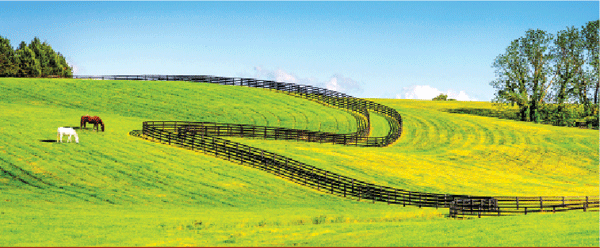
Research is essential in planning a fence installation. Consider the following before buying supplies or calling a contractor:
Zoning: Each state and some local municipalities have requirements defining fence zoning. Local laws should be researched before purchasing materials needed for a fence project. Contact your local Cooperative Extension office about allowable materials, height and location limitations.
Utility locations: Using a utility-locating service is necessary to pinpoint the proper underground clearance before starting any installation project. Utility location is the process of identifying and labeling public-utility mains that are underground, including lines for telephones, electricity distribution, natural gas, cable television, fiber optics, traffic lights, street lights, storm and water drains and wastewater pipes. Call Before You Dig, JULIE, Digger’s Hotline, One-call, Miss Utility and Underground Service Alert are examples of services that can help. Failure to call such a number ahead of time may result in a fine or even a criminal charge if such negligence causes a major utility outage or serious accident.
Animal type: There are many types of fence that are designated as the best for a specific purpose (horses, cattle, sheep and goats, dogs, garden) but some fences will restrain several different species of animals. Imagine what purposes you may have in the future before selecting the type of fence you plan to install. Also consider whether you intend to keep something in, keep something out or both, as that will help determine what style of fence will be most effective.
Animal pressure: When selecting the best fence to meet your needs, consider how much pressure your animals will exert against the fencing. The amount of pressure your fence will be subject to can be determined by comparing the number of animals in the pasture to its size. The higher the number of animals and their level of activity, the more stress on the fence. In addition, fence lines near the barn, run-in, feeding and water areas will sustain more pressure than other areas. Also, depending on what is on the other side of the fence, adjoining properties can cause stress. For instance, are there greener grazing pastures or perhaps other animals across the fence?
Temporary or permanent use: While permanent fencing is usually required for the perimeter of your property, subdividing the interior may be necessary. For example, pastureland may be segmented differently every few months to rest overgrazed sections. For this and other pasture-management needs, a temporary fence is desirable.
Gates: Determine early in your planning where you want your gate(s) located. Consider the amount of room the gate will need to swing open to be sure there is a safe margin between the gate and buildings or other obstructions. Try to avoid low-lying muddy areas, but also consider where the opening should be for the greatest convenience. The gate’s width should be determined based on its service. Do you need to accommodate a simple wheelbarrow or a large tractor? Well-constructed gates, properly hung and braced, save time in operation and reduce maintenance costs.
Brace and line posts: Brace and line posts serve as the anchor for the entire fence construction and are the foundation of any fence, so their importance cannot be overemphasized. Don’t cut corners when selecting materials and installing posts, as a fence is only as solid and reliable as these supports. Be sure that the brace posts are thick enough to hold the pressure of a taught fence, set deep enough and properly braced. Line posts must be spaced appropriately and strong enough to support the fencing material.
Materials and labor: Installing a new fence is a substantial investment in both time and materials. Keep in mind that the cost of the fence itself may be only about one-third the total cost of a fencing project. Other factors to consider are posts, gates, accessories, tools and labor. Therefore, to achieve a reliable, long-lasting fence, be sure to select the best materials your budget will allow. Take care to plan ahead, purchase quality materials and properly install the fencing; your investment can pay dividends for years
to come.
Dain Rakestraw is responsible for the marketing, communications and strategic business development of the entire line of Red Brand® Agricultural Fencing Products. He’s been with the company since 2003.











